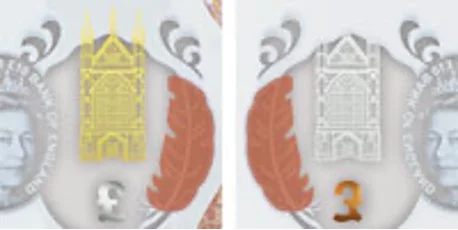Fair or fake? How to identify counterfeit polymer bank notes
Our friends at the Bank of England have contacted us to say they have seen a limited number of attempts to forge the new £10 and £20 polymer notes.
Thankfully counterfeits are at an historic low and the main targets remain the paper £20 and £50, so it’s important that your staff know how to check both paper and polymer notes. However, in recent weeks the Bank of England has seen very low volumes of counterfeits of the polymer £10 and £20 printed onto a plastic material.
Using two quick, simple checks together, which are highlighted in the Bank of England’s training materials, will ensure that criminals do not deceive you and your staff.
1. Hologram image change
Look for the hologram image change under the main see-through window on the front of the note. It will change from POUNDS to FIVE, TEN or TWENTY depending on the value of the note being examined.


2. See-through window
On the £20, the metallic image of a lighthouse is gold and blue on the front of the note, and only silver on the back.

On the £10, the metallic image of Winchester cathedral is gold on the front on the note and silver on the back.
NOTE: counterfeits seek to replicate this, so this check must be used in conjunction with the above hologram image change.

If you are still uncertain after the above checks, for a £10 note you can also check that the book surrounding the letters JA on the back of the note is made from a metallic, copper-coloured foil and not just printed ink. The equivalent for the polymer £20 is a round, purple foil patch containing the letter ‘T’. In both cases, you will find this feature on the back of the note, directly behind the silver crown on the front of the note.




Update on “composite” counterfeit notes containing genuine parts
In the Banknote Checking Scheme November newsletter, scheme supporters were alerted to the threat from composite counterfeit notes that use part of a genuine note to create a counterfeit. The Bank of England are seeing very low numbers of these, but please remain vigilant as the area that you would normally check for the features may be the genuine portion of the note. However, the notes are crudely assembled so if you are presented with a note that has been joined/repaired with tape, check whether both printed serial numbers (located on the back) are identical. If the serial numbers are different, the note should be reported as a counterfeit to your local police even if the note passes the tests described above, regardless of denomination and whether it is paper or polymer. Some versions are targeted at machines, so please check with your machine supplier and install the latest software as soon as possible.
The new polymer £50 note
The Bank of England will issue a new polymer £50 on 23 June 2021 completing its series of polymer banknotes. You can find out the most up to date information on all notes on the Bank of England website.

Scottish & Northern Ireland banknotes
The Association of Commercial Banknote Issuers produce a range of free educational materials to help you and your staff identify genuine Scottish and Northern Ireland notes.
All Scottish and Northern Ireland note-issuing banks have now issued polymer £20 notes. Bank of Scotland have announced that they will issue a new polymer £50 note on 1st July 2021.